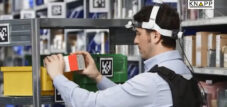[In collaboration with Kardex Remstar – ADVERTISING]
Fast and precise order picking with optical scanning systems
Even in times of increasing automation in logistics, manual order picking of items and goods remains a core activity. Thanks in no small part to the high flexibility offered by human labor, goods are still handled manually in many companies today. However, the advantages of this flexibility are offset by disadvantages; compared to automated systems, humans achieve significantly lower picking rates, and these rates are also more prone to errors.
So what chances does this seemingly old-fashioned method have compared to the highly sophisticated, fully automated retrieval systems controlled by advanced warehouse management software? Especially when speed is essential for the storage and retrieval of products, or the picking and preparation of goods for shipment, while simultaneously requiring high picking accuracy, manual handling seems to easily fall behind.
However, there are solutions that can help humans in this situation. Pick-to-light systems, in particular, often offer a way to at least partially offset the disadvantage humans face compared to machines.
Even with the help of technology based on optical signals, which supports employees in the storage and retrieval of items, a picking accuracy of up to 100 percent can be achieved. Furthermore, the visual signals enable faster access to the parts to be moved, thus increasing the picking rate.
Depending on the investment volume and the type of existing warehouse system, there are various ways to achieve this. For example, the intralogistics provider Kardex Remstar lists the following options for its equipment:
LED information strip
This system operates using either LED lights or a laser module, which is movably mounted above the retrieval opening of a storage system. The laser beam indicates from above the precise position where an item should be placed. The direct light pulse to the selected location enables particularly fast and precise access. This system integrates well with existing vertical storage lifts or shuttles.
A system has been developed specifically for horizontal carousel storage systems that uses LED signals to indicate the correct level and the corresponding compartment containing the item for the current order. These devices are typically installed between two carousel storage units and can provide the information to both units.
This is a relatively inexpensive solution; it can be easily integrated into existing systems.
Another simple solution, particularly suitable for warehouses equipped with conventional shelving, is the use of illuminated displays in front of each compartment. These displays indicate to the warehouse worker the exact location of the items for their current order. Additional information, such as the number of units to be picked, can also be displayed.
Data acquisition using camera systems
A further step forward compared to scanning technology using LEDs and lasers is the integration of highly complex camera systems for intralogistics processes. When these devices are used in goods receiving or order picking, their integrated image recognition software allows for the generation of significantly more information compared to conventional light pulses. In addition to the mere location and number of items, the camera immediately captures further data on the size and condition of the goods and can potentially detect damage to the selected product. Scanning item codes is also easily possible, as is text recognition using OCR software. This makes it possible to capture entire texts with the system. Furthermore, the images allow for more precise process monitoring, thus offering the opportunity to increase warehouse efficiency based on the analyzed data.
Due to their very small footprint, camera systems can usually be integrated relatively easily into existing systems and can also be used as a supplement to existing pick-by-light modules.
Pick-by-Vision
Examples of key information included are:
- Article number
- Number of parts to be removed
- Location/Shelf row
- Location of the sampling compartment
- Verification of the picked item using a barcode scan
When the order picker sets off, displayed arrows indicate to him which route he should take through the warehouse in order to reach the storage or retrieval point as quickly as possible.
However, the smart glasses are not a one-way street where the warehouse worker is only occupied with completing the assigned tasks. Instead, the order picker can interact with the pick-by-vision system himself, either via a handheld input device or voice control, and thus make changes.
Besides increased and more accurate picking performance, the system has the disadvantage of requiring employees to adjust and embrace this technological change. The currently rather unwieldy size and weight of the devices could also negatively impact acceptance. However, with the ongoing development of such communication systems, not least due to the pioneering work of internet giants like Google and Amazon, it can be assumed that the glasses will be more compact in the near future.

